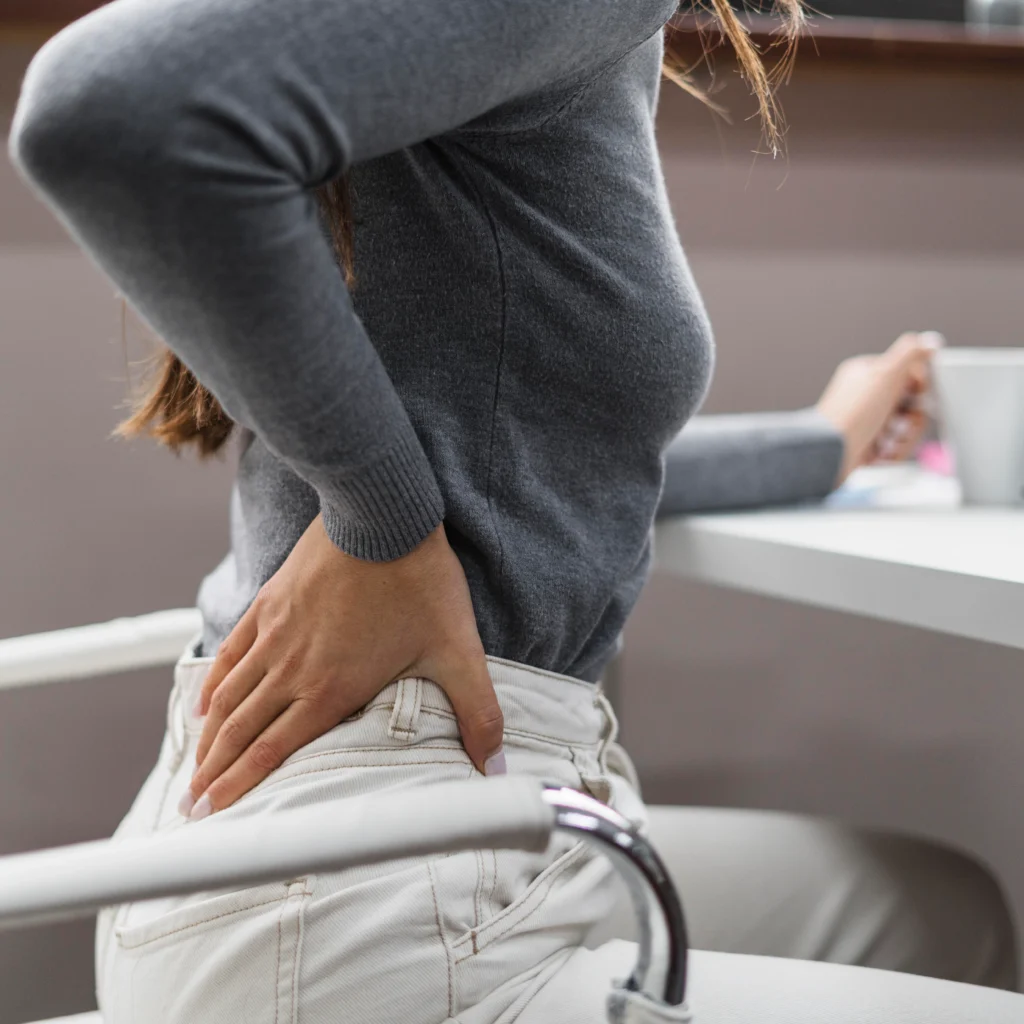Pelvic pain in women can be a complex and multifaceted condition with various underlying causes. Ranging from gynaecological issues such as menstrual cramps, endometriosis, and ovarian cysts to urinary tract infections and musculoskeletal disorders, the origins of pelvic pain are diverse. Pregnancy-related factors, pelvic inflammatory disease, and gastrointestinal issues also contribute to this discomfort. Understanding the myriad causes of pelvic pain in women is essential for accurate diagnosis and effective management.
Given the intricate interplay of reproductive, urinary, and digestive systems in the pelvic region, a comprehensive approach is crucial to address the diverse factors contributing to pelvic pain in women.
What Is Pelvic Pain?

Pelvic pain refers to discomfort or pain in the lower abdominal region, below the belly button, and between the hip bones. It can vary from dull aches to sharp pains and may be acute or chronic. Pelvic pain can stem from a myriad of causes, including gynaecological issues like menstrual cramps, endometriosis, or ovarian cysts, as well as urinary tract infections, musculoskeletal problems, and gastrointestinal issues. In women, it may also be associated with pregnancy-related conditions.
The diverse causes of pelvic pain in women underscore the importance of a thorough medical evaluation to pinpoint the underlying cause and implement appropriate treatment.
What Causes Of Pelvic Pain In Women?
Pelvic pain in women can be attributed to a variety of underlying causes, ranging from gynaecological issues to gastrointestinal and musculoskeletal disorders. Understanding the potential factors contributing to pelvic pain is crucial for accurate diagnosis and effective management.
Gynaecological Conditions
- Menstrual Disorders: Conditions like endometriosis, adenomyosis, and fibroids can be significant causes of pelvic pain in women, especially during menstruation.
- Pelvic Inflammatory Disease (PID): Infections of the reproductive organs, often resulting from sexually transmitted infections, can lead to inflammation and pain.
Reproductive Issues
- Ovarian Cysts: It is one of the leading causes of pelvic pain in women. Fluid-filled sacs on the ovaries can cause pain, particularly if they rupture or become twisted.
- Ectopic Pregnancy: When a fertilized egg implants outside the uterus, it can lead to pelvic pain and is a medical emergency.
Musculoskeletal Causes
- Pelvic Floor Dysfunction: Weak or tight pelvic floor muscles can result in chronic pelvic pain.
- Joint Dysfunction: Issues with the sacroiliac joint or the pubic symphysis may cause discomfort.
Gastrointestinal Disorders
- Irritable Bowel Syndrome (IBS): This common digestive disorder can cause abdominal pain that may be perceived as pelvic pain.
- Inflammatory Bowel Disease (IBD): Conditions like Crohn’s disease or ulcerative colitis may involve the pelvic region, leading to pain.
Urinary Issues
- Urinary Tract Infections (UTIs): Infections in the bladder or urinary tract can cause pelvic discomfort.
- Interstitial Cystitis: A chronic condition affecting the bladder, leading to pelvic pain and urgency.
Pelvic Pain Symptoms: What Are They?

Pelvic pain manifests as discomfort or pain in the lower abdomen and pelvic region and can be indicative of various underlying conditions. Recognizing the symptoms associated with pelvic pain is essential for early diagnosis and appropriate medical intervention.
Menstrual Changes
- Irregular menstrual cycles
- Menstrual cramps that are more severe than usual
- Painful periods (dysmenorrhea)
Gynaecological Symptoms
- Pain during or after sexual intercourse (dyspareunia)
- Vaginal bleeding between periods
- Abnormal vaginal discharge
- Painful urination or bowel movements
Reproductive Issues
- Difficulty getting pregnant
- Pelvic pain associated with ovulation
- Painful ovulation (mittelschmerz)
Urinary Symptoms
- Frequent urination
- Urgency to urinate
- Pain or discomfort during urination
Gastrointestinal Symptoms
- Bloating
- Constipation or diarrhoea
- Abdominal cramping
- Pain or discomfort after eating
Musculoskeletal Symptoms
- Pain in the pelvic joints
- Discomfort with specific movements or positions
- Pain that worsens with prolonged sitting or standing
General Symptoms
- Chronic pelvic pain lasting six months or longer
- Pain that is sharp, stabbing, dull, or aching
- Pain that radiates to the lower back or thighs
Emergency Symptoms
- Sudden, severe pelvic pain
- Unexplained or abnormal vaginal bleeding
- Fainting or lightheadedness
- Severe pain with fever and vomiting which could indicate a medical emergency like ectopic pregnancy or ovarian torsion.
It is crucial to consult with a healthcare professional if experiencing persistent or severe pelvic pain, as it could be indicative of various conditions, including gynaecological, gastrointestinal, or urinary issues. Timely evaluation and diagnosis of the causes of pelvic pain in women are essential for appropriate management and relief of pelvic pain.
Pain In The Right Side Of The Pelvic Female

Experiencing Pelvic Pain in the Right Side Women’s region can be attributed to various underlying causes, ranging from reproductive issues to gastrointestinal concerns. Gynecological conditions such as ovarian cysts, endometriosis, or pelvic inflammatory disease may lead to discomfort in this specific area. Additionally, issues related to the appendix, kidneys, or the digestive system could also manifest as right-side pelvic pain in women. It is crucial for women experiencing persistent or severe discomfort to seek prompt medical attention, as accurate diagnosis is essential for appropriate treatment. Consulting a healthcare professional, such as a gynaecologist or general practitioner, will involve the following:
- A thorough medical history review.
- Physical examination.
- Potentially, imaging tests to identify the root cause of the female pelvic pain on the right side.
Addressing the underlying issue is vital not only for alleviating the symptoms but also for ensuring overall reproductive and general health. Any sudden or worsening pain, accompanied by additional symptoms like fever or nausea, should be promptly evaluated to rule out severe conditions and facilitate timely intervention. This pain can also arise in the left side pelvic pain in women, so you should know the cause to treat the pain.
What Can I Do At Home To Treat Pelvic Pain In Women?
- Warm Compresses – Applying a warm compress to the pelvic area can help relax muscles and alleviate tension, reducing pelvic pain.
- Pelvic Floor Exercises – Perform pelvic floor exercises, such as Kegels, to strengthen and support the muscles in the pelvic region, promoting better stability.
- Yoga And Stretching – Engage in gentle yoga or stretching exercises to improve flexibility and release tension in the pelvic muscles.
- Maintain Good Posture – Correct posture can alleviate pressure on the pelvic region. Sit and stand with a straight back to prevent exacerbating pelvic pain.
- Hydration And Dietary Changes – Ensure adequate hydration and consider dietary adjustments, such as reducing inflammatory foods, to support overall pelvic health.
- Over-The-Counter Pain Relief – Use over-the-counter pain relievers, following recommended guidelines, to manage mild to moderate pelvic pain.
- Stress Reduction Techniques – Practice stress-reducing activities like deep breathing, meditation, or mindfulness to relax both the body and mind, which can positively impact pelvic pain.
- Pelvic Support Devices – Utilize pelvic support devices like cushions or pillows when sitting for extended periods to reduce pressure on the pelvic area.
- Consult With A Healthcare Professional – If pelvic pain persists or worsens, consult with a healthcare professional for a thorough evaluation and personalized treatment plan. They can identify underlying causes and recommend specific interventions tailored to your condition.
FAQ More About Causes Of Pelvic Pain In Women
What Is The Reason For Pelvic Pain?
There can be multiple causes of pelvic pain in women from various sources, including gynaecological issues, urinary tract problems, musculoskeletal conditions, or gastrointestinal issues. Identifying the underlying cause is crucial for effective treatment.
Can Pelvic Pain Be Serious?
Yes, pelvic pain can be severe, indicating underlying medical conditions. Prompt evaluation by a healthcare professional is essential to determine the cause and initiate appropriate treatment.
What Gynecologic Disorders Can Lead to Pelvic Pain in Women?
Gynecologic disorders such as uterine fibroids, ovarian cysts, and pelvic inflammatory disease are common causes of pelvic pain in women.
Can Menstrual Cramps Cause Pelvic Pain in Women?
Yes, menstrual cramps, also known as dysmenorrhea, can cause pelvic pain in women during their menstrual cycle.
How Do Uterine Fibroids Contribute to Pelvic Pain in Women?
Uterine fibroids, benign growths in the uterus, can cause pelvic pain in women by putting pressure on surrounding organs or causing abnormal bleeding.
What Is the Connection Between Pelvic Inflammatory Disease and Pelvic Pain in Women?
Pelvic inflammatory disease (PID), an infection of the female reproductive organs, can lead to pelvic pain in women due to inflammation and scarring of the pelvic tissues.
Can Bladder Infections Cause Pelvic Pain in Women?
Yes, bladder infections, also known as urinary tract infections (UTIs), can cause pelvic pain in women due to inflammation and irritation of the bladder and surrounding tissues.
How Does an Ectopic Pregnancy Contribute to Pelvic Pain in Women?
An ectopic pregnancy, where the fertilized egg implants outside the uterus, can cause pelvic pain in women due to the stretching and potential rupture of the fallopian tube.
What Role Does Pelvic Floor Dysfunction Play in Pelvic Pain in Women?
Pelvic floor dysfunction, which involves weakness or tightness of the pelvic floor muscles, can contribute to pelvic pain in women by affecting pelvic organ support and function.
Are Inflammatory Diseases Linked to Pelvic Pain in Women?
Yes, inflammatory diseases such as endometriosis and pelvic inflammatory disease (PID) are associated with pelvic pain in women due to inflammation and tissue damage in the pelvic area.
Conclusion –
It is crucial to understand the multifaceted causes of pelvic pain in women. Seeking medical advice is essential for accurate diagnosis and tailored treatment plans. Embracing innovative therapy, such as pelvic floor exercises and innovative therapy PC, can provide effective solutions for enhanced women’s health and overall well-being.





